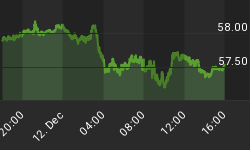Excerpted from the May 2, 2009 edition of Notes From the Rabbit Hole
I always enjoy following the market's twists, turns, ups and downs. But this is serious business as well, because it is our livelihood, our money and our financial survival that is at stake.
For perspective, let's look at the striking view provided by the yield curve measuring long term treasuries vs. t-bills. The story of this chart is one of increasing moral hazard, of a game with ever higher stakes for winners and losers and it is a story in which the sustainability of the current system is called into question.

Long term interest rates have risen strongly (weak demand for the government's long term debt) despite the Fed and Treasury's best efforts to talk them down and Larry Summers' red herrings thrown out for public consumption. Short rates, despite the supposed hints at recovery in the system, have been on the decline relative to long term treasuries.
Again, when people (or nations) buy t-bills, they are buying relative safety. Safety from what? That is a key question going forward. When people and/or entities buy t-bills for no return, one must consider the need for capital preservation above all else. There are two scenarios in play that can be driving demand for t-bills.
1) The next phase of contraction is locked and loaded and as was the case in the initial impulse of the oncoming would-be depression, smart money is looking to avoid asset destruction in the next deflationary impulse, or...
2) With long term rates on the rise and world governments (we'll focus on the US) in 'inflate or die' mode, refuge in t-bills provides two benefits; it preserves capital while at the same time it mitigates the effects of inflationary policies now in effect. By 'mitigates' I mean t-bills do not help in an inflationary environment, but at least they do not compound the problem of value erosion the way long term treasuries do.
Whatever the motivation, I think it is safe to assume that the smarter money has positioned in t-bills relative to the money that resides in the 'safety' of long term treasuries. This latter money obviously believes Mr. Larry Summers. Larry wouldn't mislead anyone would he?
Lawrence Summers, director of Obama's National Economic Council, said Thursday there have been no indications that investors are growing worried about the size of the deficits. On the contrary, he said yields on Treasury securities have been pushed lower by increased demand from investors seeking to hold Treasury bonds as a safe haven in uncertain economic times. - AP April 11, 2009
Well, how are those 'investors' feeling right about now? Risk is rising and I get the feeling that unsophisticated 'investors' have been encouraged to take their eyes off the ball at the exact moment when major sovereign counterparties desired to reposition on the curve, to the short end.
Other measures of increasing risk, even as our long awaited hopeful mood intensifies, will be shown later in the report.
















